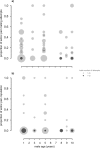Male age is associated with extra-pair paternity, but not with extra-pair mating behaviour
- PMID: 29849085
- PMCID: PMC5976671
- DOI: 10.1038/s41598-018-26649-1
Male age is associated with extra-pair paternity, but not with extra-pair mating behaviour
Abstract
Extra-pair paternity is the result of copulation between a female and a male other than her social partner. In socially monogamous birds, old males are most likely to sire extra-pair offspring. The male manipulation and female choice hypotheses predict that age-specific male mating behaviour could explain this old-over-young male advantage. These hypotheses have been difficult to test because copulations and the individuals involved are hard to observe. Here, we studied the mating behaviour and pairing contexts of captive house sparrows, Passer domesticus. Our set-up mimicked the complex social environment experienced by wild house sparrows. We found that middle-aged males, which would be considered old in natural populations, gained most extra-pair paternity. However, both, female solicitation behaviour and subsequent extra-pair matings were not associated with male age. Further, copulations were more likely when solicited by females than when initiated by males (i.e. unsolicited copulations). Male initiated within-pair copulations were more common than male initiated extra-pair copulations. To conclude, our results did not support either hypothesis regarding age-specific male mating behaviour. Instead, female choice, independent of male age, governed copulation success, especially in an extra-pair context. Post-copulatory mechanisms might determine why older males sire more extra-pair offspring.
Conflict of interest statement
The authors declare no competing interests.
Figures




Similar articles
-
Measuring Pre- and Post-Copulatory Sexual Selection and Their Interaction in Socially Monogamous Species with Extra-Pair Paternity.Cells. 2021 Mar 11;10(3):620. doi: 10.3390/cells10030620. Cells. 2021. PMID: 33799610 Free PMC article.
-
Age-dependent trajectories differ between within-pair and extra-pair paternity success.J Evol Biol. 2017 May;30(5):951-959. doi: 10.1111/jeb.13058. Epub 2017 Apr 3. J Evol Biol. 2017. PMID: 28235138
-
Male age and its association with reproductive traits in captive and wild house sparrows.J Evol Biol. 2019 Dec;32(12):1432-1443. doi: 10.1111/jeb.13542. Epub 2019 Sep 26. J Evol Biol. 2019. PMID: 31529748 Free PMC article.
-
Why do females mate multiply? A review of the genetic benefits.Biol Rev Camb Philos Soc. 2000 Feb;75(1):21-64. doi: 10.1017/s0006323199005423. Biol Rev Camb Philos Soc. 2000. PMID: 10740892 Review.
-
An integrative view of sexual selection in Tribolium flour beetles.Biol Rev Camb Philos Soc. 2008 May;83(2):151-71. doi: 10.1111/j.1469-185X.2008.00037.x. Biol Rev Camb Philos Soc. 2008. PMID: 18429767 Review.
Cited by
-
Removal of older males increases extra-pair siring success of yearling males.PLoS Biol. 2024 Apr 16;22(4):e3002584. doi: 10.1371/journal.pbio.3002584. eCollection 2024 Apr. PLoS Biol. 2024. PMID: 38626215 Free PMC article.
-
Male survivorship and the evolution of eusociality in partially bivoltine sweat bees.PLoS One. 2022 Oct 20;17(10):e0276428. doi: 10.1371/journal.pone.0276428. eCollection 2022. PLoS One. 2022. PMID: 36264953 Free PMC article.
-
Sperm Morphology and Male Age in Black-Throated Blue Warblers, an Ecological Model System.Animals (Basel). 2020 Jul 10;10(7):1175. doi: 10.3390/ani10071175. Animals (Basel). 2020. PMID: 32664407 Free PMC article.
-
Analysis of within-individual variation in extrapair paternity in blue tits (Cyanistes caeruleus) shows low repeatability and little effect of changes in neighborhood.Behav Ecol. 2020 Oct 1;31(6):1303-1315. doi: 10.1093/beheco/araa069. eCollection 2020 Nov-Dec. Behav Ecol. 2020. PMID: 33281500 Free PMC article.
-
Opposite-sex associations are linked with annual fitness, but sociality is stable over lifetime.Behav Ecol. 2023 Mar 8;34(3):315-324. doi: 10.1093/beheco/arac124. eCollection 2023 May-Jun. Behav Ecol. 2023. PMID: 37192923 Free PMC article.
References
-
- Cleasby IR, Nakagawa S. The influence of male age on within-pair and extra-pair paternity in passerines. Ibis (Lond. 1859). 2012;154:318–324. doi: 10.1111/j.1474-919X.2011.01209.x. - DOI
-
- Akcay E, Roughgarden J. Extra-pair paternity in birds: review of the genetic benefits. Evol. Ecol. Res. 2007;9:855–868.
-
- Hansen TF, Price DK. Good genes and old age: Do old mates provide superior genes? J. Evol. Biol. 1995;8:759–778. doi: 10.1046/j.1420-9101.1995.8060759.x. - DOI
Publication types
MeSH terms
LinkOut - more resources
Full Text Sources
Other Literature Sources

